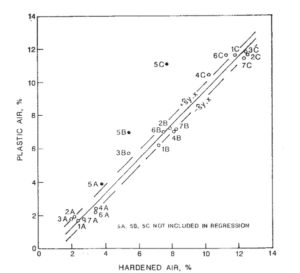Air entrained concrete is still the biggest headache in concrete production. We have recently been discussing comparisons between the pressure meter and the microscope. It may seem counterintuitive, but the microscope came first.
Many studies show the relationship between the air content determination by ASTM C457, a petrographic method, and that by the pressure method, ASTM C23.

In the 1930s, T.C. Powers discovered that small air voids in concrete will protect it from damage due to freezing and thawing. The methods Powers used—microscopic examination and gravimetric testing—were too slow for quality control.
Air content of fresh concrete
The development of the volumetric air meter for determining the air content of plastic concrete dates to the late 1940s, according to ASTM STP 169B. Since then, numerous studies have confirmed the correlation between the volumetric meter and the hardened air determinations.
M. Muethel performed one such study for the Michigan Department of Transportation in 1995. The figure shows a close correlation between the two methods.
It is reasonable to conclude that the air contents of fresh and hardened concrete are the same. Sometimes discrepancies between the two occur.
There are a few things to keep in mind:
-
- The air void quantity and air void characteristics measured in hardened concrete are the final word.
- Conventional entrained air bubbles cannot manifest in concrete that has already been placed. The air was in the concrete mixture before placement even if the pressure meter reportedly measured something different.
- Some entrained air bubbles are too small to measure with a pressure meter, but they are not likely to make up a majority of the entrained air void volume.
Here’s the formal title of this 1995 report: Muethel, R.W. “Investigation of the air content of plastic vs hardened concrete.” Michigan Department of Transportation Research Project 90 TI-1500, Research report No. R1332, 1995.
